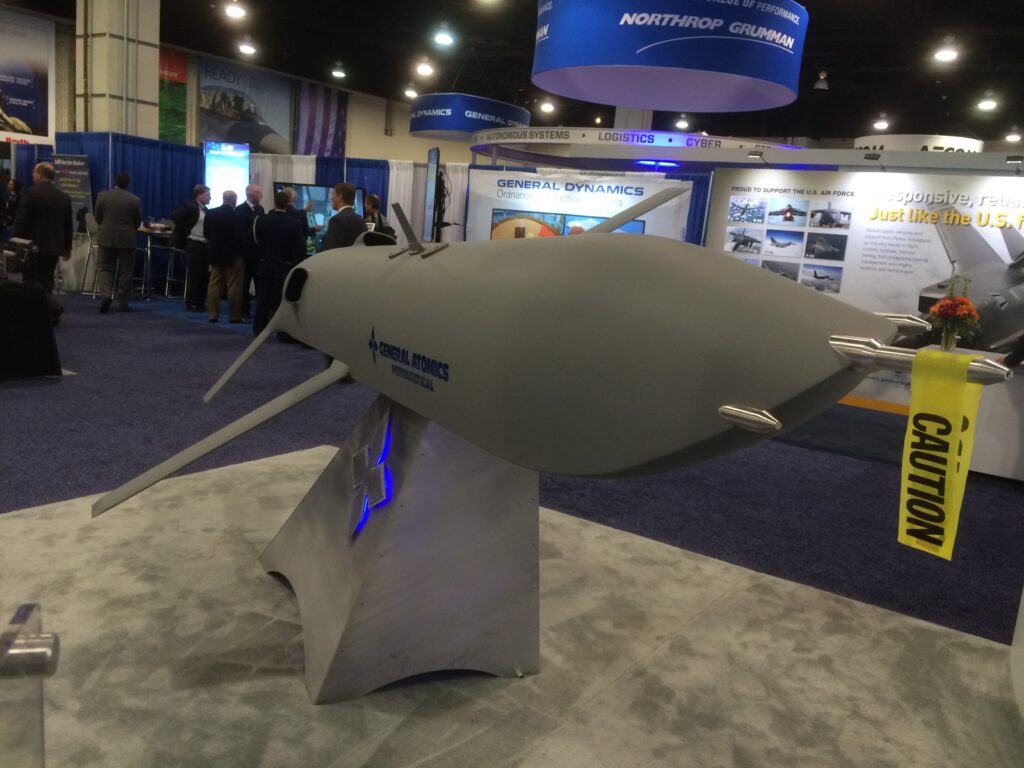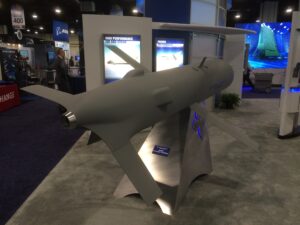How To ‘Land’ A Drone On A Manned Airplane: DARPA’s ‘Gremlins’
Posted on

General Atomics SUAS drone
NATIONAL HARBOR: This time, General Atomics’ secret weapon isn’t the drone. It’s the mechanical arm that catches it in mid-flight — and then hauls it into the back of a C-130 cargo plane, also in mid-flight.
General Atomics, which builds the iconic Predator, has rolled out its offering for DARPA’s Gremlins program, blandly called the Small Unmanned Air Vehicle (SUAS). The goal: Build drones — and equally critical, a launch and recovery system — that can take off from a manned aircraft, conduct a mission and come back aboard the plane.
Getting the drone back is “the DARPA-hard part,” said Chris Pehrson, General Atomics VP for Strategic Development in an interview at the Air Force Association conference here last week. GA’s solution blends sophisticated software with cartoony mechanics, as if their senior engineer were Wiley E. Coyote.
They recover the drone with “a mechanical arm that comes down and grabs it,” Pehrson told me. “It’s almost like a Transformer-type thing.”

General Atomics SUAS drone
General Atomics also has a more “elegant” solution, a mechanism mounted under the C-130’s wing that reels out a cable on which the drone can catch, then reels it back in. It’s similar to the hose-and-drogue system used by the US Navy and many allies to refuel in mid-air, Pehrson told me, or downrigger used for deep-sea fishing.
But the reel-in-reel-out mechanism doesn’t meet the Gremlins requirement, Pehrson acknowledged, because you can’t fit very many drones under an aircraft’s wings. Gremlins wants to pack the cargo bay with drones, 16 of them, to make the mothership a kind of airborne aircraft carrier. The only way to get drones in and out of the cargo bay is with that mechanical arm.
Why is DARPA pushing companies to such outré engineering? It isn’t to be able to launch drones from another aircraft, because that problem is largely solved. MIT students 3D-printed disposable Perdix drones small enough to fit in existing flare dispensers — or in the palm of a Deputy Defense Secretary’s hand — while ever-more-sophisticated cruise missiles increasingly resemble drones, albeit drones you can only use once.
But “use once” is the problem DARPA wants to solve. Perdix and missiles can be smart, but they also have to be disposable, because there’s no way to get them back after launch. If you want to make something disposable, you can’t load it up with sophisticated sensors or other expensive components. But if you figure out a way to get the air-launched unmanned vehicle back, you can afford to equip it with the same kind of sensors you’d put on a regular ground-launched reconnaissance drone.
Right now, though, the Gremlins program is just focusing on launch and recovery. That’s hard enough. Each drone must be between 500 and 1,000 pounds, with room for 60 pounds of payload and enough fuel to fly out 300 miles, loiter over a target for an hour, and fly back 300 miles to the mothership for recovery.
The C-130 is particularly tricky, Perhson said. It’s got lots of room, but it’s also a “dirty” aircraft that creates a lot of turbulence. The goal with either the mechanical arm or the reel-in-reel-out system is to get the drone safely outside the worst turbulence before launching it, and then, on recovery, to catch it when it’s still far enough away that, again, it’s not being battered by turbulence. The General Atomics system uses precision sensors to determine the relative position of the drone and the catching mechanism, with software using negative feedback to steer the drone more and more precisely onto target so it can be caught and recovered.
“The challenging part was the last two to three feet of closure to connect with a mechanism to bring it back towards the mothership and do it safely,” Pehrson told me. But he declined to provide us further details of how the recovery system works, let alone any pictures. That, he said, is General Atomics’ secret sauce.
Subscribe to our newsletter
Promotions, new products and sales. Directly to your inbox.
